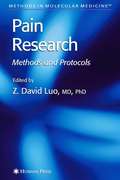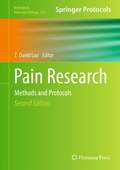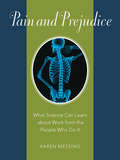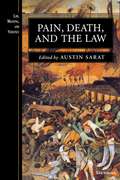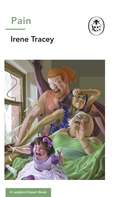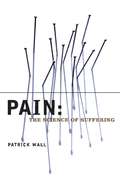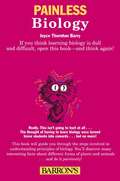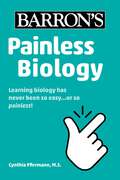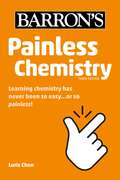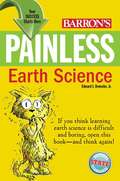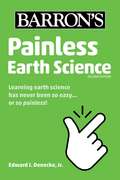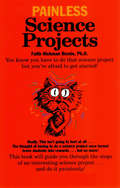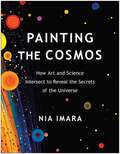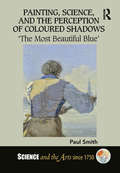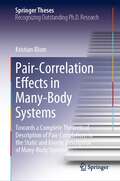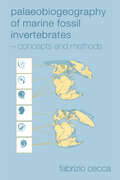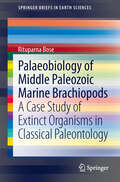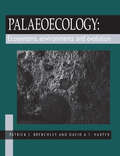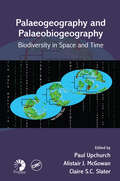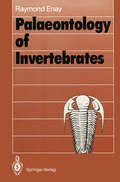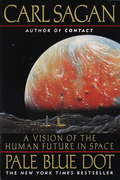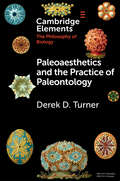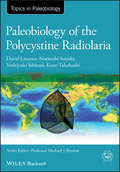- Table View
- List View
Pain Research
by Z. David LuoA cutting-edge collection of diverse readily reproducible techniques for dissecting the molecular mechanisms of pain transduction. These methods employ a variety of multidisciplinary approaches ranging from animal pain models and single neutron selection to in vitro single-cell mRNA amplification. The collection includes not only standard and cutting-edge methods, but also novel techniques only recently applied to pain research. The protocols follow the successful Methods in Molecular BiologyTM series format, each one offering step-by-step laboratory instructions, an introduction outlining the principle behind the technique, lists of equipment and reagents, and tips on troubleshooting and avoiding known pitfalls.
Pain Research, 2nd Edition
by Z. David LuoThe advancements of medical technology, improvements in medical care, and increased patients’ life span make pain research and related drug development high priorities for both the research community and pharmaceutical companies. Rapid development of basic science research tools, such as techniques of flurometric labeling, genomic and proteomic high throughput screening, and genetically modified animals, promotes the swift acceleration of pain research to a stage allowing integrated investigations of pain processing mechanisms at the single cell and/or molecule level, and in a spatially and temporally controlled manner. Using multidisciplinary approaches, we can dissect the complicity of the sensory circuits connecting peripheral stimulation to maladaptive changes in the sensory pathways as well as pain perceptions at the central nervous system. Pain Research: Methods and Protocols, Second Edition provides advanced techniques and animal models that are critical for integrated pain research. Written in the highly successful Methods in Molecular Biology™ series format, chapters contain introductions to their respective topics, lists of the necessary materials and reagents, step-by-step, readily reproducible laboratory protocols, and notes on troubleshooting and avoiding known pitfalls.<P><P> Authoritative and accessible, Pain Research: Methods and Protocols, Second Edition serves as an ideal guide to novice pain researchers who may not have extensive experiences in the field, or to experienced pain researchers who would like to expand their research in new directions and/or to new mechanisms in different models.
Pain and Prejudice: What Science Can Learn About Work From The People Who Do It
by Dr Karen MessingIn 1978, when workers at a nearby phosphate refinery learned that the ore they processed was contaminated with radioactive dust, Karen Messing, then a new professor of molecular genetics, was called in to help. Unsure of what to do with her discovery that exposure to the radiation was harming the workers and their families, Messing contacted senior colleagues but they wouldn’t help. Neither the refinery company nor the scientific community was interested in the scary results of her chromosome studies. Over the next decades Messing encountered many more cases of workers around the world—factory workers, cleaners, checkout clerks, bank tellers, food servers, nurses, teachers—suffering and in pain without any help from the very scientists and occupational health experts whose work was supposed to make their lives easier. Arguing that rules for scientific practice can make it hard to see what really makes workers sick, in Pain and Prejudice Messing tells the story of how she went from looking at test tubes to listening to workers.
Pain, Death, and the Law
by Austin SaratThis collection of essays examines the relationship between pain, death, and the law and addresses the question of how the law constructs pain and death as jurisprudential facts. The empirical focus of these essays enables the reader to delve into both the history and the theoretical complexities of the pain-death-law relationship. The combination of the theoretical and the empirical broadens the contribution this volume will undoubtedly make to debates in which the right to live or die is the core issue at hand.
Pain: A Ladybird Expert Book (The Ladybird Expert Series #39)
by Irene TraceyPART OF THE ALL-NEW LADYBIRD EXPERT SERIES- What is pain and can we measure it?- What is chronic pain and can we treat it?- Can we make pain pleasant?UNDERSTAND the causes and the reasons for pain. This complex, subjective but vital perception is experienced by the entire animal kingdom. We may not enjoy feeling it, but living without pain would be dangerous - it is our body's way of telling us when something isn't right.YOUR BODY'S BUILT IN ALARM SYSTEMWritten by Professor of Anaesthetic Neuroscience at the University of Oxford, Irene Tracey, PAIN is an accessible and fascinating illustrated introduction to one of our body's most important sensory and emotional experiences.
Pain: The Science of Suffering (Maps of the Mind)
by Patrick WallPain is one of medicine's greatest mysteries. When farmer John Mitson caught his hand in a baler, he cut off his trapped hand and carried it to a neighbor. "Sheer survival and logic" was how he described it. "And strangely, I didn't feel any pain." How can this be? We're taught that pain is a warning message to be heeded at all costs, yet it can switch off in the most agonizing circumstances or switch on for no apparent reason. Many scientists, philosophers, and laypeople imagine pain to operate like a rigid, simple signaling system, as if a particular injury generates a fixed amount of pain that simply gets transmitted to the brain; yet this mechanistic model is woefully lacking in the face of the surprising facts about what people and animals do and experience when their bodies are damaged. Patrick Wall looks at these questions and sets his scientific account in a broad context, interweaving it with a wealth of fascinating and sometimes disturbing historical detail, such as famous characters who derived pleasure from pain, the unexpected reactions of injured people, the role of endorphins, and the power of placebo. He covers cures of pain, ranging from drugs and surgery, through relaxation techniques and exercise, to acupuncture, electrical nerve stimulation, and herbalism. Pain involves our state of mind, our social mores and beliefs, and our personal experiences and expectations. Stepping beyond the famous neurologic gate-control theory for which he is known, Wall shows that pain is a matter of behavior and its manifestation differs among individuals, situations, and cultures. "The way we deal with pain is an expression of individuality."
Painless Biology
by Joyce BarryThis book (formerly titled Painless Life Science), proves that biology can be both intriguing and enjoyable. The author helps students solve puzzles and find answers to questions as they learn to classify living things from bacteria and viruses to plants and animals. Other topics covered include cells, parts of the plant, animals in their environments, human body systems, genetics, ecology, natural selection, and general health issues.
Painless Biology (Barron's Painless)
by Cynthia PfirrmannWhether you&’re a student or an adult looking to refresh your knowledge, Barron&’s Painless Biology provides review and practice in an easy, step-by-step format.An essential resource for:Virtual LearningHomeschoolLearning podsSupplementing classes/in-person learningInside you&’ll find:Comprehensive coverage of biology, including, nature of science, cell anatomy, biochemistry, animals and plants, genetics, and much more Diagrams, charts, and instructive science illustrations Painless tips, common pitfalls, and informative sidebars Brain Tickler quizzes and answers throughout each chapter to test your progress
Painless Chemistry (Barron's Painless)
by Loris ChenBarron's makes learning Chemistry fun and PAINLESS!Painless Chemistry provides lighthearted, step-by-step learning and includes:Complex topics broken down with examples and illustrations, including atomic theory, chemical bonding, the structure of molecules, and moreThe Periodic Table of Elements and how it offers the key to understanding ChemistryPainless tips, instructive tables,&“Brain Tickler&” quizzes and answers throughout each chapter, and more.
Painless Earth Science
by Edward J. Denecke Lynette LongTitles in Barron's extensive Painless Series cover a wide range of subjects as they are taught on middle school and high school levels. Perfect for supporting state standards, these books are written for students who find the subjects unusually difficult and confusing--or in many cases, just plain boring, and may need a little extra help. Barron's Painless Series authors' main goal is to clear up students' confusion and perk up their interest by emphasizing the intriguing and often exciting ways in which they can put each subject to practical use. Most of these books take a light-hearted approach to their subjects, often employing humor, and always presenting fun-learning exercises that include puzzles, games, and challenging "Brain Tickler" problems to solve. This title describes the exciting revolution in our understanding of Earth's processes and changes, focusing on movement of tectonic plates, earthquakes, volcanoes, and much more.
Painless Earth Science (Barron's Painless)
by Edward J. Denecke Jr.Learning at home is now the new normal. Need a quick and painless refresher? Barron&’s Painless books make learning easier while you balance home and school. Titles in Barron's extensive Painless Series cover a wide range of subjects as they are taught on middle school and high school levels. Perfect for supporting state standards, these books are written for students who find the subjects unusually difficult and confusing--or in many cases, just plain boring, and may need a little extra help.Barron's Painless Series authors' main goal is to clear up students' confusion and perk up their interest by emphasizing the intriguing and often exciting ways in which they can put each subject to practical use. Most of these books take a light-hearted approach to their subjects, often employing humor, and always presenting fun-learning exercises that include puzzles, games, and challenging "Brain Tickler" problems to solve. This title describes the exciting revolution in our understanding of Earth's processes and changes, focusing on movement of tectonic plates, earthquakes, volcanoes, and much more.
Painless Science Projects
by Hank Morehouse Faith Hickman BrynieHelp for middle school students with science fair projects
Painting the Cosmos: How Art and Science Intersect to Reveal the Secrets of the Universe
by Nia ImaraA stunning portrait of our vast, dynamic, and mysterious universe . . . as seen through the lenses of astronomy and artWhat is our place in the universe? Where do art and science overlap? How can we use these disciplines to better understand the universe . . . and how do they help us to shape our reality? In Painting the Cosmos, astrophysicist and visual artist Nia Imara combines these perspectives to comprehensively illustrate the history of the universe and our position in it. In this eye-opening and accessible book, Imara asks pivotal questions and explores humanity&’s ever-evolving view of nature. Richly illustrated with spectacular full-color images of our universe and beautiful work from creators around the world—particularly the often-neglected work of women and Black artists—this one-of-a-kind book unites the realms of art, science, and culture to create a dynamic portrait of the cosmos. From the Big Bang to life on other planets—while also explaining the most exciting recent developments in astronomy—with Imara&’s guiding expertise, readers will explore: The limits of objectivity in understanding reality The role of harmony and rhythm in the universe and art How light functions as a storyteller How scientists and artists help us &“see&” the invisible—from black holes to marginalized experiences The possibility of life beyond our solar system, and how we define intelligence Painting the Cosmos will captivate and inspire you to see the world around you in a brand new, fascinating light where space and art are beautifully intertwined.
Painting, Science, and the Perception of Coloured Shadows: ‘The Most Beautiful Blue’ (Science and the Arts since 1750)
by Paul SmithMany artists and scientists – including Buffon, Goethe, and Philipp Otto Runge – who observed the vividly coloured shadows that appear outdoors around dawn and dusk, or indoors when a candle burns under waning daylight, chose to describe their colours as ‘beautiful’. Paul Smith explains what makes these ephemeral effects worthy of such appreciation – or how depictions of coloured shadows have genuine aesthetic and epistemological significance. This multidisciplinary book synthesises methodologies drawn from art history (close pictorial analysis), psychology and neuroscience (theories of colour constancy), history of science (the changing paradigms used to explain coloured shadows), and philosophy (theories of perception and aesthetic value drawn from Wittgenstein and Merleau-Ponty). This title will be of interest to scholars in art history, art theory, and the history of science and technology.
Painting, Science, and the Perception of Coloured Shadows: ‘The Most Beautiful Blue’ (Science and the Arts since 1750)
by Paul SmithMany artists and scientists – including Buffon, Goethe, and Philipp Otto Runge – who observed the vividly coloured shadows that appear outdoors around dawn and dusk, or indoors when a candle burns under waning daylight, chose to describe their colours as ‘beautiful’. Paul Smith explains what makes these ephemeral effects worthy of such appreciation – or how depictions of coloured shadows have genuine aesthetic and epistemological significance. This multidisciplinary book synthesises methodologies drawn from art history (close pictorial analysis), psychology and neuroscience (theories of colour constancy), history of science (the changing paradigms used to explain coloured shadows), and philosophy (theories of perception and aesthetic value drawn from Wittgenstein and Merleau-Ponty). This title will be of interest to scholars in art history, art theory, and the history of science and technology.
Pair-Correlation Effects in Many-Body Systems: Towards a Complete Theoretical Description of Pair-Correlations in the Static and Kinetic Description of Many-Body Systems (Springer Theses)
by Kristian BlomThe laws of nature encompass the small, the large, the few, and the many. In this book, we are concerned with classical (i.e., not quantum) many-body systems, which refers to any microscopic or macroscopic system that contains a large number of interacting entities. The nearest-neighbor Ising model, originally developed in 1920 by Wilhelm Lenz, forms a cornerstone in our theoretical understanding of collective effects in classical many-body systems and is to date a paradigm in statistical physics. Despite its elegant and simplistic description, exact analytical results in dimensions equal and larger than two are difficult to obtain. Therefore, much work has been done to construct methods that allow for approximate, yet accurate, analytical solutions. One of these methods is the Bethe-Guggenheim approximation, originally developed independently by Hans Bethe and Edward Guggenheim in 1935. This approximation goes beyond the well-known mean field approximation and explicitly accounts for pair correlations between the spins in the Ising model. In this book, we embark on a journey to exploit the full capacity of the Bethe-Guggenheim approximation, in non-uniform and non-equilibrium settings. Throughout we unveil the non-trivial and a priori non-intuitive effects of pair correlations in the classical nearest-neighbor Ising model, which are taken into account in the Bethe-Guggenheim approximation and neglected in the mean field approximation.
Palaeobiogeography of Marine Fossil Invertebrates: Concepts and Methods
by Fabrizio CeccaSitting squarely at the interface between earth and life sciences, palaeobiogeographic information is scattered throughout many publications. Until now. Palaeobiogeography of Marine Fossil Invertebrates covers important theoretical concepts relating to palaeobiogeography together with descriptions of analytical methods. Fabrizio Cecca discusses general biogeographical concepts and the factors influencing distributional patterns using illustrative case histories. Cecca uses the palaeobiogeography of fossil organisms to generate hypotheses on continental drifting, past migration routes, palaeobiodiversity gradients, geographic barriers, palaeoclimatic and paleooceanographic conditions. He explores the biogeographical dimension of biodiversity through the analysis of existing latitudinal and longitudinal gradients of biodiversity and discusses the biodiversity/area relationship with particular reference to sea-level variations.
Palaeobiology of Middle Paleozoic Marine Brachiopods
by Rituparna BoseFossil species appear to persist morphologically unchanged for long intervals of geologic time, punctuated by short bursts of rapid change as explained by the Ecological Evolutionary Units (EEUs). Here, morphological variation in Paleozoic atrypide morphology at the subfamily level (Atrypinae and Variatrypinae) from the Silurian and Devonian time intervals in the third Paleozoic EEU (~444-359 my) were investigated using relatively new techniques of quantitative modeling. The study explains how a group of closely related taxa in atrypide subfamilies exhibit morphological conservation through time in P3 EEU within the Eastern North America region.
Palaeoecology: Ecosystems, Environments and Evolution
by P.J. Brenchley D.A.T HarperThe first palaeoecology book to focus on evolutionary palaeoecology, in both marine and terrestrial environments. Discusses reconstruction of the past ecological world at population, community and biogeographic levels. A well-illustrated and substantial volume giving accessible coverage of the full range of subjects within palaeoecology. Reviews and summarises all the major mass extinctions.
Palaeogeography and Palaeobiogeography: Biodiversity in Space and Time (Systematics Association Special Volumes)
by Paul Upchurch Alistair J. McGowan Claire S.C. SlaterBiogeography represents one of the most complex and challenging aspects of macroevolutionary research, requiring input from both the earth and life sciences. Palaeogeographic reconstruction is frequently carried out by researchers with backgrounds in geology and palaeontology, who are less likely to be familiar with the latest biogeographic techniq
Palaeontology of Invertebrates
by Raymond EnayHow could life have started on Earth and how did it proceed? After a short discussion on the origin of life on Earth and the origin of the major body plans the invertebrates are presented in the order of increasing complexity by the most significant fossil representatives. In each case, the adaptive significance of the respective forms and/or structures which more or less profoundly changed the original body plan is treated in detail. In the closing chapter, some general aspects of invertebrates in evolution and palaeoecology, palaeobiogeography and biochronology are outlined.
Palaeopathology
by Tony WaldronPaleopathology is designed to help bone specialists with diagnosis of diseases in skeletal assemblages. It suggests an innovative method of arriving at a diagnosis in the skeleton by applying what are referred to as "operational definitions. " The aim is to ensure that all those who study bones will use the same criteria for diagnosing disease, which will enable valid comparisons to be made between studies. This book is based on modern clinical knowledge and provides background information so that those who read will understand the natural history of bone diseases, and this will enable them to draw reliable conclusions from their observations. Details of bone metabolism and the fundamentals of basic pathology are also provided, as well as a comprehensive and up-to-date bibliography. A short chapter on epidemiology provides information on how best to analyze and present the results of a study of human remains.
Pale Blue Dot: A Vision of the Human Future in Space
by Carl Sagan Ann DruyanIn Cosmos, the late astronomer Carl Sagan cast his gaze over the magnificent mystery of the Universe and made it accessible to millions of people around the world. Now in this stunning sequel, Carl Sagan completes his revolutionary journey through space and time.<P> Future generations will look back on our epoch as the time when the human race finally broke into a radically new frontier--space. In Pale Blue Dot Sagan traces the spellbinding history of our launch into the cosmos and assesses the future that looms before us as we move out into our own solar system and on to distant galaxies beyond. The exploration and eventual settlement of other worlds is neither a fantasy nor luxury, insists Sagan, but rather a necessary condition for the survival of the human race.
Paleoaesthetics and the Practice of Paleontology (Elements in the Philosophy of Biology)
by Derek D. TurnerThe practice of paleontology has an aesthetic as well as an epistemic dimension. Paleontology has distinctively aesthetic aims, such as cultivating sense of place and developing a better aesthetic appreciation of fossils. Scientific cognitivists in environmental aesthetics argue that scientific knowledge deepens and enhances our appreciation of nature. Drawing on that tradition, this Element argues that knowledge of something's history makes a difference to how we engage with it aesthetically. This means that investigation of the deep past can contribute to aesthetic aims. Aesthetic engagement with fossils and landscapes is also crucial to explaining paleontology's epistemic successes.
Paleobiology of the Polycystine Radiolaria (TOPA Topics in Paleobiology)
by Noritoshi Suzuki David Lazarus Yoshiyuki Ishitani Kozo TakahashiPolycystine radiolaria are exclusively marine protists and are found in all ocean waters, from polar regions to the tropics, and at all water depths. There are approximately 600 distinct described living species and several thousand fossil species of polycystines. Radiolarians in general, and polycystines in particular, have recently been shown to be a major component of the living plankton and important to the oceanic carbon cycle. As fossils radiolarians are also fairly common, and often occur in sediments where other types of fossils are absent. This has made them very valuable for certain types of geologic research, particularly estimating the geologic age of the sediments containing them, and as guides to past oceanic water conditions. As our current understanding of the biology, and even taxonomy of the living fauna is still very incomplete, evolutionary studies based on living polycystines are still rare. However, the common occurrence of numerous specimens for many species, and in a wide variety of oceanic environments, provides an excellent opportunity to study the processes of biologic evolution in the fossil record. Paleobiology of the Polycystine Radiolaria is the first major book on radiolarians to appear in the western literature since 2001. Focusing on living and fossil siliceous shelled radiolarians, it is notable for its emphasis not upon morphologic or taxonomic detail but on concepts and applications. The book attempts to provide a balanced, critical review of what is known of the biology, ecology, and fossil record of the group, as well as their use in evolutionary, biostratigraphic and paleoceanographic research. Full chapters on the history of study, and molecular biology, are the first ever in book form. Written for an audience of advanced undergraduate to doctoral students, as well as for a broad range of professionals in the biological and Earth sciences, Paleobiology of the Polycystine Radiolaria summarizes current understanding of the marine planktonic protist group polycystine radiolaria, both in living and fossil form.
